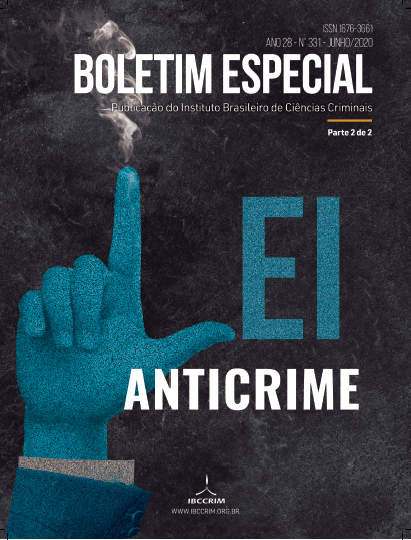“Anticrime law”: possible reading from criminal guaranteeism
Views: 194Keywords:
“Anticrime Law”, Criminal guaranteeism, (In)compatibilitiesAbstract
The article aims to present, in general, the context of elaboration and publication of the “Anti-crime Statute Law” to situate its legislative changes in the brazilian Criminal and Procedural Criminal Law in order to investigate the levels of compatibility with the criminal guaranteeism proposed by Luigi Ferrajoli for being a consistent theory, committed to fundamental rights and guarantees and founded on a rigid Constitution model such as the Brazilian Constitution of 1988.
Downloads
Publication Facts
Reviewer profiles N/A
Author statements
- Academic society
- Instituto Brasileiro de Ciências Criminais
- Publisher
- IBCCRIM
References
COUTINHO, Jacinto Nelson de Miranda. Introdução aos princípios gerais do processo penal brasileiro. Revista da Faculdade de Direito da UFPR, Curitiba, ano 30, n. 30, 1998.
COUTINHO, Jacinto Nelson de Miranda. Observações sobre os sistemas processuais penais. Curitiba: Observatório da Mentalidade Inquisitória, 2018.
FERRAJOLI, Luigi. Democracia y garantismo. Edición de Miguel Carbonell. Madrid: Trotta, 2008.
FERRAJOLI, Luigi. Derecho y razón: teoría del garantismo penal. Madrid: Trotta, 2000.
FERRAJOLI, Luigi. Diritto e ragione: teoria del garantismo penale. 10. ed. Roma: Gius. Laterza & Figli, 2011.
FERRAJOLI, Luigi. Principia iuris: teoría del derecho y de la democracia. 2. Teoría de la democracia. Madrid: Trotta, 2011.
GLOECKNER, Ricardo Jacobsen. Autoritarismo e processo penal: uma genealogia das ideias autoritárias no processo penal brasileiro, v. 1. Florianópolis: Tirant lo Blanch, 2018.
IPPOLITO, Dario. Lo spirito del garantismo: Montesquieu e il potere di punire. Roma: Donzelli editore, 2016.
PINHO, Ana Cláudia Bastos de; ALBUQUERQUE, Fernando da Silva; SALES, José Edvaldo Pereira. O garantismo (penal) de Luigi Ferrajoli: apontamentos (des)necessários a certas ‘críticas’ Made in Brazil. In: Revista do Instituto de Hermenêutica Jurídica, Belo Horizonte/MG, Ed. Fórum, ano 17, n. 26, p. 155-186, jul./dez. 2019.
Downloads
Published
How to Cite
Issue
Section
License
Copyright of published articles belongs to the author, but with journal rights over the first publication and respecting the one-year exclusivity period. Authors may only use the same results in other publications by clearly indicating this journal as the medium of the original publication. If there is no such indication, it will be considered a situation of self-plagiarism.
Therefore, the reproduction, total or partial, of the articles published here is subject to the express mention of the origin of its publication in this journal, citing the volume and number of this publication. For legal purposes, the source of the original publication must be consigned, in addition to the DOI link for cross-reference (if any).


 Português (Brasil)
Português (Brasil)
 English
English
 Español (España)
Español (España)






